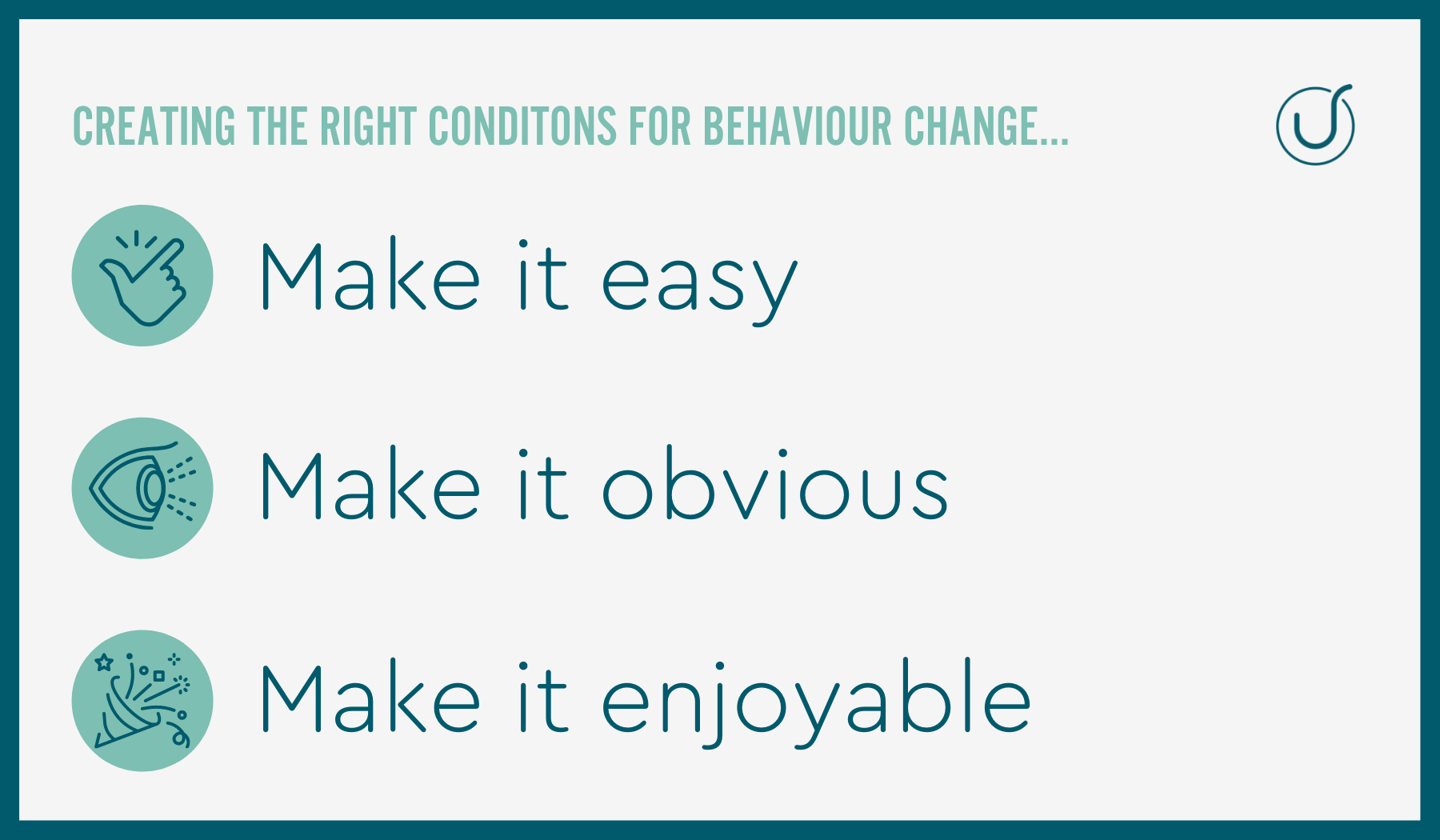
Creating the optimal conditions for behaviour change: make it easy, obvious and enjoyable
By Carolyn Quainton in Behaviour, Consultancy, Customer, Employee engagement, Inspiration
If you want to change your life, you have to change your behaviour. And if you want to change the culture of your organisation, you have to change the behaviour of your employees.
But how do you create the right conditions for the right behaviours to thrive and survive?
In last month’s blog post we looked at two main reasons why we so often fail to create sustainable behaviour change:
1. We take on too much at a time. If we want to create meaningful, long-term change, we need to start small. It’s all about breaking down an aspiration into bite-sized chunks.
2. We’re too ‘goal-obsessed’. Instead of focusing on the goal we want to achieve, we should consider the person we want to become (and the processes/systems we need to put in place to get us there).
Best-selling authors B.J. Fogg (Tiny Habits) and James Clear (Atomic Habits) explain how to create the right conditions to build the right habits. We’ve distilled their ideas into three key principles:

1. Make it easy
Easy behaviours dominate our lives. With a couple of clicks we can order a takeout, or buy a new sofa.
The easier a habit is, the higher the chances you’ll adopt it. So let’s apply the concept of ‘low effort’ to our desired behaviours with these suggestions:
- Reduce or increase friction. You can reduce friction to turn a beneficial behaviour into a habit, but you can also increase friction if you want to kill a bad habit. Want to watch less TV? Unplug it and take the batteries out of the remote. Want to eat fewer biscuits? Don’t have them in the house. And if you do, store them in a cupboard that’s hard to access.
- Apply the two-minute rule. Break the desired behaviour into steps that only take two minutes (or less). If you want to read more books, don’t commit to reading one book per week. Instead, make a habit of reading one or two pages per night. Simply getting started is the first and most important step towards doing something.
2. Make it obvious
Wherever you are, you’re surrounded by prompts that trigger specific responses: the traffic light turns to green and you hit the accelerator; your phone buzzes and you reach to check it. So why not design prompts to trigger your own desired behaviours?
- Alter your environment. Let’s say you want to learn the guitar but you struggle to keep up with the practice. Try keeping your instrument in the middle of the living room, in full view. That way, the ‘cue’ is visible and unmissable.
- Use ‘action prompts’. These are behaviours you already perform, which prompt you to initiate new behaviours. Any pre-existing behaviour can become a prompt for a new one. For example: Want to do more strength training? Every time you’re waiting for the kettle to boil, do 10 squats in your kitchen.
3. Make it enjoyable
When building a new habit, if we make it something we look forward to, we’ll be much more likely to actually do it. Here are two ways of making an unattractive task a bit more appealing:
- Associate it with a reward. Most “good” behaviours need time before we enjoy the fruits of our labour (one visit to the gym won’t result in a six pack). So to stay motivated to continue good habits, find ways to create rewards that are instantly fulfilling. Connect habits you do to things you want to do. Say you’re studying for an exam, reward yourself with an hour of Netflix after an hour of study.
- Adopt a positive attitude. How ‘enjoyable’ something is depends on how we look at it. Try redefining the behaviour as an ‘opportunity’ instead of an ‘obligation’. Reframe something you ‘have to’ do with something you ‘get to’ do. This subtle shift changes our perspective and helps us to focus on the positive elements of the behaviour.
Change behaviour in your organisation
So let’s now consider behaviour change at an organisational level. Imagine you have a team of customer-facing employees who are receiving low satisfaction scores and multiple complaints. You want your team to change their behaviour and deliver great customer service by being warm, friendly, empathetic and helpful. So let’s apply our principles to change their behaviour:
- Make it easy. Break down your aspiration into small and manageable steps (the first rule of behaviour change). Why not start with getting them to smile at every single customer who comes in (to the shop, hotel, train station etc)? If you focus on a single, achievable small behaviour change (smiling), you’re more likely to have success.
- Make it obvious. Provide some kind of prompt to cue the behaviour of smiling e.g. pictures, mirrors, signs. Smiling is infectious so make sure team managers are also smiling! The behaviour of other people can also provide that prompt and motivation for others to adopt the right behaviour.
- Make it enjoyable. Sell the multiple benefits of smiling (Google it – there are dozens!) Demonstrate what’s in it for them to smile (boosts the immune system, makes you look more attractive, diffuses conflict). This will encourage them to adopt a more positive attitude towards the behaviour and they’ll enjoy the rewards that smiling brings!
How we can help you
So many training courses fail to deliver the behaviour change they promise. And that’s because their sole focus is on imparting knowledge and information. To successfully embed real behaviour change, your people need to engage in the ‘how’ and the ‘why’: the strategies, the mindset, the motivation. And that’s where we can help you.
Contact us if you’d like to chat about how we can help you to create long-lasting behavioural change in your organisation.
